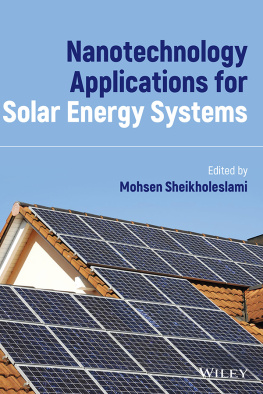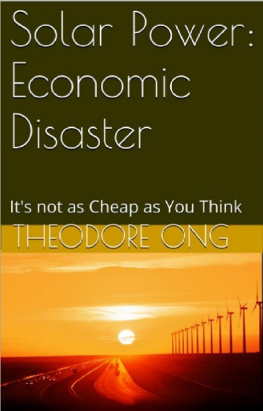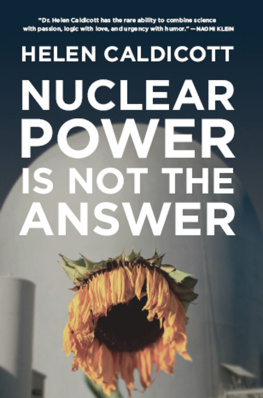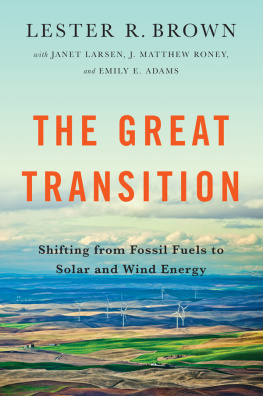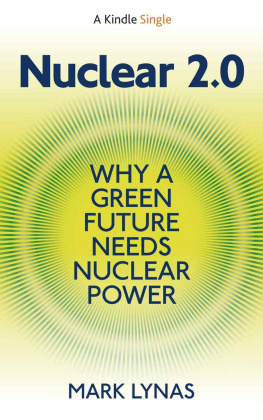THE
BURNING ANSWER
THE SOLAR REVOLUTION:
A QUEST FOR SUSTAINABLE POWER
KEITH BARNHAM

THE BURNING ANSWER
ISBN: 978-1-60598-776-7
ISBN: 978-1-60598-777-4 (e-book)
Pegasus Books LLC
80 Broad Street, 5th Floor
New York, NY 10004
Copyright 2014 by Keith Barnham
First Pegasus Books hardcover edition May 2015
All rights reserved. No part of this book may be reproduced in whole or in part without written permission from the publisher, except by reviewers who may quote brief excerpts in connection with a review in a newspaper, magazine, or electronic publication; nor may any part of this book be reproduced, stored in a retrieval system, or transmitted in any form or by any means electronic, mechanical, photocopying, recording, or other, without written permission from the publisher.
Distributed by W. W. Norton & Company, Inc.

Preface to the American Edition
This book is about the solar revolution that will enable the sun to supply all our energy needs. It can help us avoid the threats posed by global warming, oil depletion, and nuclear disaster.
Readers will find The Burning Answer is, in fact, three books in one. The first part is a popular science history. It describes how the solar revolution developed from the semiconductor revolution that started in America after the Second World War. It explains the workings of the solar cell and the silicon chip in your laptop computer. The second part is environmental politics, describing how the renewable technologies are developing in Europe and why Germany is now leading the solar revolution. The third part is futurology. It predicts how sunlight could power our transport and how America could win back leadership of this part of the solar revolution.
The book also unravels a number of mysteries. You will meet some surprising solutions that physicists found to apparently conflicting observations. Some political mysteries, like the case of the missing British plutonium, are solved. Others, like the motivations for the obsession some politicians have with nuclear power and fossil fuels, are left for readers to make their own judgement.
The Burning Answer also contains more unlikely coincidences than the average Victorian novel. The physics of the semiconductor and solar revolutions contains some amazing coincidences without which we would not have modern computers or solar cells. At the personal level, my own career in solar research has involved some coincidences, only one of which was unlucky.
But first a love story. I fell in love with the city of Berkeley in California. My first wife, Judith, to whom this book is dedicated, agreed with me that the happiest two years of our lives were spent there. I was a young post-doc in experimental particle physics at the University of California. Our first daughter, Nicole, was born in the Kaiser Hospital in Oakland. Both our daughters, Nicole and Cleo, had naming ceremonies at Glide Memorial Methodist church in San Francisco. At Cal I taught my first two undergraduate physics courses. This was a formative experience in my research, teaching, and political development, so I will describe it briefly.
The students were bright and motivated. I struggled, having been an undergraduate myself only a few years earlier. Much of the material was new to me. In mid-course, while I was barely a lecture ahead of the students, President Richard Nixon ordered the invasion of Cambodia. As in many other American universities, the Berkeley student body went on strike. Half my students wanted to strike, the others wanted to carry on. I had the extra burden of producing printed lecture notes to satisfy both sides. I learnt a lot about the complex relationship between science and politics at this time. The experience also convinced me I wanted to teach. I therefore later took the offer of a tenured lectureship at Imperial College London rather than a short-term research contract back at CERN.
Berkeley is at one extreme of the social and political spectrum of America. But I want this books message, that we can all play a part in the solar revolution, to reach Americans across the country. I want all of you, whatever your political views, social standing, or scientific knowledge, to be aware there are simple, and increasingly cheap, low-carbon answers to the burning of fossil and nuclear fuels. This is true in states where the quality and quantity of the sunshine is inferior to California.
I also love the continental land mass of your country and have deep admiration for most of the people that I have met there. Judith and I loved to drive along your coastline, through the mountains, and across your deserts. When Judiths illness was diagnosed as terminal, we flew back to the USA to revisit old friends and our favourite locations. A year later, in the company of Nicole, Cleo, and their partners Karl and Stewart, we covered the same ground in her memory. Five years later, my second wife Claire and I had our honeymoon in northern New Mexico in one of the many beautiful parts of the US that I had never visited.
Two odysseys across America by car and plane were particularly important in the second half of my career when I researched solar cells. Both journeys were undertaken before I realised the importance of travelling by train and boat, whenever possible, to reduce my carbon footprint. I recall driving between particle physics meetings in Chicago and Washington, D.C. through some of the finest farm land in America, listening to local baseball and music stations. The lengthy and solitary drive was an opportunity to ponder a question which had been nagging for some time. Was research in such an exciting area of physics, with no obvious practical application, an indulgence in a world that had so many pressing problems? describes how a paper by an American futurologist pointed me towards research in solar, or photovoltaic (PV), cells. However, this lengthy and lonely trip on Interstate highways was important in deciding I needed to switch to a more practical subject and to ensure my laboratory would be closer to home and to my students.
Fast-forward nine years to when I had made the change. This had been helped by a sabbatical year at Philips Research Laboratories and by joining the group of the late Professor Tony Stradling at Imperial. As I describe in , I decided that quantum-well nanostructures, which were being widely researched at the time for lasers, would also be useful in third-generation PV cells. In the late 1980s America was still leading in solar-cell research. I therefore took another trip westward to seek advice from the experts as to whether this idea was crazy and, if not, to seek funding.
Meetings with university academics and researchers at the National Renewable Energy Laboratory (NREL) went well. Arriving on the west coast, I was apprehensive about my final encounter at a solar-cell company. I was to meet Jan Werthen at Varian in Silicon Valley. He led the group which at the time manufactured the worlds most efficient PV cells. I stopped in a coffee shop to fortify myself. By coincidence, the muzak in the restroom was the same as on all the local radio stations during my influential drive from Chicago to Washington nine years earlier (Count on Me by Jefferson Starship). I decided this was a good omen, and so it proved. Jan was very friendly and positive about using quantum wells. But, like the academics, he cautioned that it was not easy to get new solar-cell ideas accepted or funded. The young industry was even more fixated then on cost.


